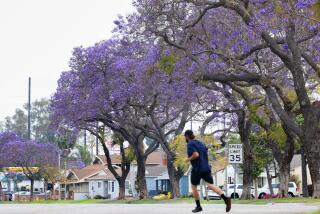Golden Days for Apricots
- Share via
It may take a little longer for this year’s apricot harvest to get rolling, but once it starts, it’ll be Katy (or, more accurately, Patterson, Tilton or even Blenheim), bar the door.
Those are all apricot varieties that begin harvesting later in the spring, and they’re the ones you’re likely to see most of this year.
Growers are expecting a total harvest almost as large as last year’s record--the second good one in a row, coming after back-to-back disasters in 1995 and 1996. The harvest will begin about 10 days later than usual, so expect to see the first apricots in the market beginning about the middle of May.
The earliest apricots, primarily the Castlebrites from south of Bakersfield, are the ones that were most affected by this winter’s crazy weather. Because of cool temperatures, the bees couldn’t do that thing that bees do during pollination.
That’s less of a problem the farther north you go. From Bakersfield, the harvest will proceed up the San Joaquin Valley, wrapping up in Winters, just north of Sacramento, in late June. The harvest around Hollister, south of Santa Clara, takes place about the same time.
In the valley, most of the apricots are Pattersons (which make up about half the state’s total harvest), Tiltons and, yes, Katys. Castlebrite, the other dominant variety, has shrunk this decade from 35% to about 20% of the harvest.
It’s in the Hollister area that most of the state’s Royals and Blenheims are produced. Those older varieties (in reality, they’re the same variety parading under different names) are the highest in quality. Still, most of them go to drying; they’re just too fragile to be shipped in large quantities over long distances. Look for them in Southern California at farmers’ markets.
While you’re at it, you might also check there and at some of the U-pick places around Ojai for the very few old-time Moorparks that are still around. They are reputed to be the best-eating apricots ever.
Overall, though, quality should be uniformly high this year, once the early Castlebrites are done. “Because of the lack of violent swings in temperature and in the weather in general, the apricots have had a chance to mature steadily,” says Tom Tjerandsen, manager of the California Fresh Apricot Council. “Because of that, we anticipate exceptionally large size and sweetness.
“It’s when you get blasts of 80 degrees for three days, then a cell moves through and it’s 55 for 10 days, that you run into problems. The trees never know what to do. Though it’s been cooler than normal, the temperatures have been in a fairly narrow spectrum throughout the entire cycle. This is going to be a great quality year.”
More to Read
Sign up for The Wild
We’ll help you find the best places to hike, bike and run, as well as the perfect silent spots for meditation and yoga.
You may occasionally receive promotional content from the Los Angeles Times.







